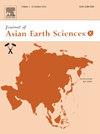水电站大坝和采砂是红河(亚洲)水文变化的原因吗?
IF 2.3
Q3 GEOSCIENCES, MULTIDISCIPLINARY
引用次数: 0
摘要
东南亚的红河(RR)为食品和能源生产提供了水,以采砂的形式提供了建筑材料,并为中国云南省和越南北部省份数百万居民的人员和货物流动提供了便利。自20世纪后期以来,该地区经济的快速发展导致了显著的人为变化。本文采用Mann-Kendall、Pettitt、Mann-Whitney和主成分分析等多重统计检验方法,对黄河下游7个水文气象站的日流量数据进行分析,旨在找出影响黄河下游水势的主要因素。研究结果表明,1989年投入使用的和平水库和2010年投入使用的松拉水库显著地改变了径流格局,使RR主支流的年平均流量从1986 - 2008年的1763 m3 s - 1减少到2009 - 2023年的1334 m3 s - 1。这项研究首次发现,在RR下游地区广泛而松散的采砂不仅降低了河床和水位,而且还增加了流入河流的地下水。因此,尽管上游山区的流量减少,但下游地区的河流流量在过去十年中在RR中保持统计不变。本文章由计算机程序翻译,如有差异,请以英文原文为准。

Are hydropower dams and sand mining responsible for hydrological change in the Red river (Asia)?
The Red River (RR) in Southeast Asia provides water for food and energy production, building materials in the form of sand mining and facilitates the movement of people and goods for millions of inhabitants in the Yunnan province in China and provinces in northern Vietnam. Since the late 20th century, rapid economic development in the region has led to significant human-induced changes to the RR. In this study, we applied multiple statistical tests (Mann-Kendall, Pettitt, Mann-Whitney and principal component analysis) to analyse daily water flow data from seven hydro-meteorological stations in the lower section of the RR, aiming to identify the primary factors altering the water flow regime. Our findings indicate that the Hoa Binh reservoir, commissioned in 1989, and the Son La reservoir, commissioned in 2010, have significantly modified the flow regime, reducing the annual mean water flow of the RR main tributary from 1763 m3 s−1 between 1986 and 2008 to 1334 m3 s−1 between 2009 and 2023. This study is the first to identify that widespread and loosely regulated sand mining in the lower RR region has not only lowered the riverbed and water levels, as reported in recent studies, but also increased groundwater discharge into the river. As a result, despite the reduced upstream water flow from the mountains, the river discharge in the downstream region has remained statistically unchanged over the past decade in the RR.
求助全文
通过发布文献求助,成功后即可免费获取论文全文。
去求助
来源期刊

Journal of Asian Earth Sciences: X
Earth and Planetary Sciences-Earth-Surface Processes
CiteScore
3.40
自引率
0.00%
发文量
53
审稿时长
28 weeks
 求助内容:
求助内容: 应助结果提醒方式:
应助结果提醒方式:


